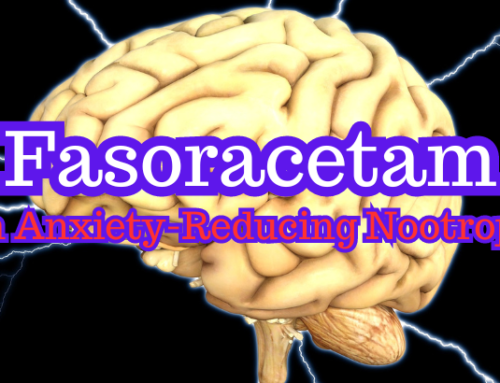Nootropics can be wonderful. They can increase focus and motivation, improve mood and memory, and reduce anxiety and stress. But nootropics can only do these things if they're taken correctly. That's why we're going to go over 10 common nootropic mistakes in this article.
Hopefully you're not making any of these nootropic mistakes. But they're all pretty common. I've even made a few of them myself at one time or another. Let's jump right into these ten common nootropic mistakes.
10 Common Nootropic Mistakes
1. Not having a purpose for your nootropic use
Why do you use (or want to use) nootropics? What are you trying to get out of them? What specific aspects of cognition are you trying to improve?
If you can't easily answer these questions, you might be making this first mistake. It's incredibly important that you have a reason for using nootropics. If you don't, it's impossible gauge how effective they are.
Before trying any new nootropic, you should have a reason for taking it. That reason doesn't have to be complicated. Simply wanting to see if a nootropic has any noticeable effect whatsoever is a reason. A better reason would be to see if it has any noticeable effect on one particular area of cognition.
For example, you might be interested in reducing anxiety without feeling overly sedated. You've heard good things about l-theanine, so you decide to give it a try. Your reason for trying it is to see if it provides you with the sedation-free anxiety reduction you've heard about. If it does, great. Now you've got a reason to use it.
2. Not giving them enough time to work
I've watched people make this mistake over and over again ever since I first got into nootropics. We live in a world where we want immediate results. Instant gratification. We want what we want and we want it right now!
To quote Mick Jagger, “You can't always get what you want.”
 When it comes to nootropics, Jagger's famous chorus definitely applies. You can't always get what you want. However, you can sometimes get immediate results with certain nootropics. Some start working right away. Things like modafinil and l-theanine are among a handful of nootropics that are often felt after just a single dose.
When it comes to nootropics, Jagger's famous chorus definitely applies. You can't always get what you want. However, you can sometimes get immediate results with certain nootropics. Some start working right away. Things like modafinil and l-theanine are among a handful of nootropics that are often felt after just a single dose.
But many nootropics take anywhere from a few days to several weeks to really start working. Some effects might be noticeable right away. But the full benefits take weeks of daily use to reach their peak.
The adaptogens are a good example of this. Take ashwagandha for example. It's something I've used off and on for years. While I do notice a slight reduction in anxiety after the very first dose, it takes at least a couple weeks for me to experience the full benefits of ashwagandha. Its anxiolytic (anxiety-reducing) effect gets stronger over time and, for some people, can take over a month to peak.
Make sure you're giving your nootropics enough time before concluding they don't work. For most nootropics, 2-4 weeks should be long enough to tell if they're working or not.
3. Not using a high enough dosage
Maybe you've recently tried a new nootropic and gave it a full month to work. But after a month it still wasn't doing anything, so you gave up on it. While it's possible this particular nootropic wouldn't have worked for you no matter what, you might've made nootropic mistake #3.
![]() Whenever you're putting anything new into your body, it's always wise to start with a low dosage and work your way up as needed. This is true for prescription drugs, supplements, dietary changes, and of course nootropics. But some people don't just start with a low dose – they end there, too.
Whenever you're putting anything new into your body, it's always wise to start with a low dosage and work your way up as needed. This is true for prescription drugs, supplements, dietary changes, and of course nootropics. But some people don't just start with a low dose – they end there, too.
Let's say you want to try phenylpiracetam because you read it can improve overall cognition and increase physical stamina. You buy a bottle of phenylpiracetam capsules from Pure Nootropics which are 100 milligrams (mg) each and start taking one every morning. After a couple of weeks, you don't notice any difference. So you assume that, for whatever reason, your body doesn't respond to it and move onto something else.
This was me the first time I tried phenylpiracetam years ago. I really thought it didn't work – not for me, anyway. But now I realize the dosage was too low. A couple of years later, I went back and tried phenylpiracetam again. This time, I experimented with 200-300 mg doses. I also tried taking it twice a day instead of just once. And guess what? It turned out to be one of the most-powerful cognitive enhancers I'd ever used.
4. Using too high of a dosage
If I had to guess, I'd say this one happens less often than nootropic mistake #3. But it definitely still happens a lot. Some people, when they hear about a particular nootropic, jump to a high dosage right from the beginning. This mistake is not only potentially costly, it can sometimes be dangerous.
More is better, right? Maybe when it comes to money, power, or tax exemptions. But when it comes to nootropics, this is rarely the case. I can't even begin to tell you how many nootropic users have told me they had to learn the hard way that less is more.
Most nootropics are extremely safe. But some, especially in high-enough doses, can cause a variety of side effects. That's why it's always a good idea to start with a low dose and gradually increase it as needed.
I knew someone who took 600 mg of armodafinil the first time they tried it. They'd never taken modafinil or adrafinil, two similar nootropics, before either. But they reasoned the more they took, the greater the benefits. That turned out to be a big mistake.
This person told me they couldn't sleep for two days, they were too overwhelmed with anxiety to focus on anything, had an upset stomach off and on for 48 hours, and completely lost their appetite during that time. Falsely, they concluded that armodafinil doesn't work.
The truth is, for most people, armodafinil works great for them. Most users find it to be as effective, if not more so, than modafinil. But if you take too much, you're likely to face all the side effects the person above described. I'll say it one more time: start low and work your way up as needed.
5. Unrealistic expectations
After the movie Limitless came out, I got hundreds of emails from people asking me which nootropic or combination of nootropics would do everything that NZT-48 does but without the side effects. NZT-48 is a fictional drug from the movie that dramatically enhances memory and intelligence, and acts as a nearly perfect antidepressant and anxiolytic.
 I repeat: NZT-48 is a fictional drug. Nothing like it exists in the real world – not yet. Perhaps someday we'll have a pill that can do everything the Limitless pill can do. I'd say the closest thing we've got today is Adderall (amphetamines), which is most certainly not a nootropic. Sure, Adderall can increase focus and motivation. But it can also cause a long list of potentially dangerous side effects including dependence, addiction, and withdrawal.
I repeat: NZT-48 is a fictional drug. Nothing like it exists in the real world – not yet. Perhaps someday we'll have a pill that can do everything the Limitless pill can do. I'd say the closest thing we've got today is Adderall (amphetamines), which is most certainly not a nootropic. Sure, Adderall can increase focus and motivation. But it can also cause a long list of potentially dangerous side effects including dependence, addiction, and withdrawal.
It's important to have realistic expectations when it comes to nootropics. They definitely can increase focus, improve memory and mood, decrease anxiety, and do all (or at least most) of the things they're claimed to be able to do. But you're not going to go from being a lazy couch potato who hasn't read a book since high school to being an energy-filled super-genius by popping a pill.
This is one of the worst nootropic mistakes you can make. If you set your expectations too high, you'll only end up being disappointed.
6. Taking nootropics at the wrong time of day
Another mistake that some people make with nootropics is that they take them at the wrong time of day. It's important to know when you should take any given nootropic. There's no one-size-fits-all answer to the question of when you should take nootropics.
 One of the most common nootropics that people take at the wrong time is modafinil. It's classified as a wakefulness-promoting drug, also known as a eugeroic. But some people underestimate how long modafinil's effects last and take it later in the day. When they do, they end up unable to sleep at night.
One of the most common nootropics that people take at the wrong time is modafinil. It's classified as a wakefulness-promoting drug, also known as a eugeroic. But some people underestimate how long modafinil's effects last and take it later in the day. When they do, they end up unable to sleep at night.
If you're pulling an all-nighter or working an overnight shift, taking modafinil later in the day may be appropriate. But if you're taking it for its general nootropic properties, it should be taken early in the day so you're able to sleep at night.
The opposite is also true. Some people take certain nootropics and other supplements too early in the day. Things like ashwagandha, magnesium, l-theanine, and others can make some users sleepy. Me, I can take all three first thing in the morning and still feel wide awake. But for others it has the opposite effect.
Don't make this common nootropic mistake. Know your body and plan accordingly. If you already have trouble sleeping, don't take caffeine or modafinil later in the day. If you're easily knocked out by things like Benadryl (diphenhydramine) or chamomile, you probably should wait until later in the day to take calming nootropics. As always, it's all about figuring out what works best for you.
7. Giving up too quickly
Many nootropics take time to work. And not all nootropics work for all people. Because of these two reasons, a lot of people give up on them too quickly. Let's address these two things separately.
 I've heard countless stories of people taking nootropics for a few days and then giving up because they didn't work. For things like rhodiola or ashwagandha that can take weeks to really kick in, this is a huge mistake. They need to be taken daily for weeks to get the full benefits.
I've heard countless stories of people taking nootropics for a few days and then giving up because they didn't work. For things like rhodiola or ashwagandha that can take weeks to really kick in, this is a huge mistake. They need to be taken daily for weeks to get the full benefits.
And you need to understand that not all nootropics work for all people. Our brains are all wired differently. What works great for you might not work at all for me. That's why it's so important to be willing to try several different nootropics if you don't get the results you want right away.
Don't be afraid to experiment on yourself a little bit. If the first thing you try doesn't work, try something else. But don't just give up. Nootropics do work. But you need to figure out which ones work for you.
8. Taking too many nootropics at once
This is another common nootropic mistake. And it's one that can be hard to avoid sometimes. As nootropics continue to grow in popularity, more and more companies are putting out products that contain several nootropics. The problem is, when you take those products, you don't know which ingredients are working and which ones aren't.

If you take a single nootropic, say modafinil, and it helps you focus and stay alert, you know it's the modafinil making you feel focused and alert. But if you take a product with 12 different nootropics in it and it helps you stay focused and alert, you have no idea which one/ones is/are responsible.
If you're new to the world of nootropics, I'd suggest only trying them one at a time to see what works for you and what doesn't. Then after you have some experience with individual nootropics, think about trying out some nootropic stacks.
9. Buying from disreputable sources
There are a million places to buy nootropics online now. When I first started the Nootropics Zone back in the summer of 2014, there were only a couple of online nootropic vendors. Now there are hundreds. But not all of them are trustworthy.
Unfortunately, as nootropics have grown in popularity, so have the number of shady companies popping up to sell them. A lot of these companies don't test the purity of their products. Some of them knowingly sell you fake products. And some will just take your money and send you absolutely nothing.
Now, I'm not trying to scare you. There are several awesome online nootropic vendors out there that have high-quality, independently tested products. You'll want to do some research to make sure you're buying from one of these vendors. And you can find our list of reputable nootropic sellers here: Where To Buy Nootropics.
Make sure you're purchasing your nootropics from reputable sellers. Don't make the mistake of buying from the first company that pops up in Google or that someone posted on some random message board. Sure, they might be legit. But they might not.
10. Thinking they don't work
This last nootropic mistake is for those of you who haven't had any success with nootropics. Either you've tried one or two and they didn't work or you haven't tried any at all. And since you haven't personally experienced any of the benefits nootropics can provide, you believe they don't work.
 Well, they do. Thousands of people around the country and around the world use nootropics to boost cognition. I'm one of those people. But I can understand why someone might be skeptical at first. Even the idea of cognitive enhancement seems a bit science-fictiony. But they are very real.
Well, they do. Thousands of people around the country and around the world use nootropics to boost cognition. I'm one of those people. But I can understand why someone might be skeptical at first. Even the idea of cognitive enhancement seems a bit science-fictiony. But they are very real.
If you don't think nootropics work, you haven't experimented enough. You either haven't tried the right nootropics, the right dosage, or used them for long enough. With so many nootropics out there, you're bound to find something that works for you. But you have to keep looking until you find it.
Not all nootropics work for all people. But nootropics do work.
Conclusion
We all make mistakes. I've made several of these nootropic mistakes over the years. But I've learned from them and am now passing that knowledge onto you. Hopefully now that you've learned about these 10 common nootropic mistakes, you won't make them yourself.
Did I miss any nootropic mistakes? If so, please leave them in the comments section at the bottom. And if you haven't already, please sign up for the NZ newsletter below.
To learn more about nootropics, sign up for the Nootropics Zone newsletter. You'll get the free gift, The Ultimate Nootropics Quick Reference Guide.







Inedequate sleep does affect on how the nootropics will or will not work and what the effects or side effects will be. Common issue is that people are looking for the high feeling like example drugs or liqour feel. Which is false.